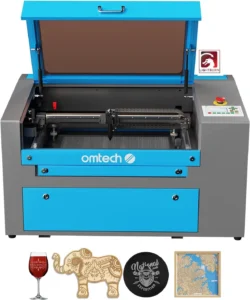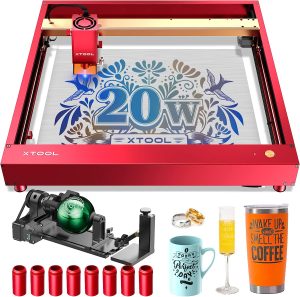From garments like jackets to stationery and novelty items, leather is a material that adds a touch of finesse and class. But nothing adds sophistication to your leather items than adding a personalized laser engraved image or quote.
Can you laser engrave leather? The answer is yes, you can! As long as you have the appropriate laser engraver, you can engrave on almost all types of leather items. Engraving on leather will add to its perceived value so it can be a great business idea but you can also do it to make unique and memorable gifts for your loved ones

Engraving leather results in a debossed effect and produces a clean contrast on the leather surface. Engraving on darker leather results in more contrast while it produces less color contrast on light-colored leathers.
Results are dependent on the leather you are working with as well as the laser you have; i.e. its speed, power, and frequency settings. You may want to test your laser machine with different parameters until you achieve your desired results.
With a laser machine you can easily “burn“ image files into leather and then color them to achieve a chic look and feel. To facilitate subsequent coloring of the lasered surface, a film may be glued which burns during the laser process.
Before the film is peeled off, the leather can then be colored in the recesses without coloring un-lasered areas. Also, leather with hair and fur can be patterned by laser. This technique is usually applied to cowhide leather.
Table of Contents
Examples of leather products you can laser engrave on
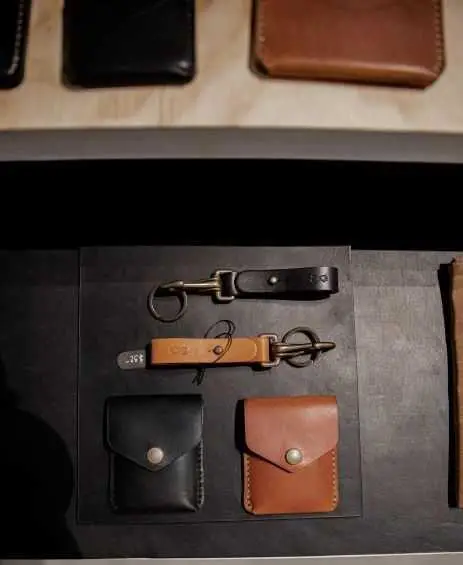
Laser engraving on leather is an excellent way to add personalization, intricate designs, or branding to a wide variety of leather products.
The precision of laser technology allows for detailed and durable engravings that can transform everyday items into custom creations.
Here are some examples of leather products that are perfect for laser engraving:
Leather Wallets
Leather wallets are a popular choice for laser engraving, offering a sleek and personalized look.
Whether it’s adding initials, a name, a company logo, or an intricate pattern, laser-engraved wallets make great gifts or promotional items.
The engravings can range from subtle monograms to bold designs that cover the entire surface.
Leather Belts
Leather belts are another common item for engraving. You can engrave a name, quote, or custom design along the length of the belt or focus on specific areas like the buckle end. Laser engraving adds a touch of uniqueness, making the belt stand out as a personal or branded accessory.
Leather Bags and Purses
From handbags to briefcases, laser engraving can elevate leather bags by adding a touch of luxury. Logos, initials, or custom artwork can be engraved to create a one-of-a-kind piece. Engraving can be placed on various parts of the bag, including straps, flaps, or even the main body of the leather.
Leather Journals and Notebooks
Leather-bound journals and notebooks offer a large, flat surface that is ideal for laser engraving. These products are perfect for engraving inspirational quotes, personal names, or logos. Customized journals are great gifts for writers, professionals, or students, and they add a timeless appeal to any collection.
Leather Phone Cases
For tech enthusiasts, leather phone cases can be beautifully customized using laser engraving. Whether it’s a sleek design, initials, or artwork, engraved phone cases offer a stylish way to personalize everyday gadgets. They provide a sophisticated look while offering protection for your devices.
Leather Shoes and Boots
Laser engraving is an innovative way to add unique details to leather shoes and boots. Whether it’s a small logo near the heel, a monogram on the side, or intricate patterns, engraving can turn standard footwear into a fashion statement. This technique is particularly popular for custom-made shoes or limited-edition releases.
Leather Bracelets and Jewelry
Leather bracelets are often personalized with engraved names, symbols, or meaningful quotes. Laser engraving can add fine details to small surfaces, making bracelets and other leather jewelry pieces more personal and meaningful. These items are popular for gifts and souvenirs.
Leather Keychains
Leather keychains offer a simple but stylish canvas for laser engraving. Personalizing keychains with names, initials, or logos makes them perfect for gifts, promotional giveaways, or personal use. Engraved leather keychains are small, functional, and add a personal touch to everyday essentials.
Leather Coasters
Leather coasters are practical and stylish items that can be easily engraved with decorative patterns, company logos, or personalized designs. These make great gifts for special events or corporate branding. Engraving on coasters adds a touch of class to any table setting.
Leather Furniture
For a luxurious touch, laser engraving can be used to add logos, patterns, or custom designs to leather furniture like chairs and couches. Whether it’s a decorative detail on an armrest or an engraved logo on a headrest, laser engraving enhances the aesthetic appeal of high-end leather furniture pieces.
Leather Passport Covers
Passport covers are frequently engraved with initials or full names to add a personal touch. Engraving designs or artwork can also give passport holders a unique, customized look, perfect for travelers who want to stand out while keeping their documents safe.
Leather Dog Collars
Laser engraving on leather dog collars is a practical and stylish way to add your pet’s name or your contact information. These personalized collars not only look great but also serve an important purpose, ensuring your pet can be identified easily.
The best budget laser engraver for engraving leather products?
Laser engraving leather has become a popular method for adding intricate designs, personalizations, and branding to a variety of leather products. Whether you’re working on small items like wallets and keychains or larger products like bags and furniture, finding the right laser engraver is essential for achieving professional-quality results.
When choosing the best laser engraver for leather, there are several factors to consider: power, precision, ease of use, and compatibility with leather materials. Here’s a guide to the best laser engravers for engraving leather products.
OMTech 50W CO2 Laser Engraver and Cutter
The OMTech 50W CO2 Laser Engraver is a powerful and versatile machine, perfect for professional use and leather engraving projects. This industrial-grade laser cutter offers high precision, impressive features, and ample workspace, making it an ideal choice for businesses and serious hobbyists.
With a large engraving area of 63″ x 40″, autofocus, autolift, and water chiller, this machine is built to handle intricate designs and heavy-duty production, especially when working with leather and other delicate materials.
Key Features:
- 50W CO2 Laser Power: Ideal for engraving and cutting through various leather thicknesses with ease.
- Large Workspace: The 63″ x 40″ working area allows users to work on large leather projects, including bags, jackets, and more.
- Autofocus and Autolift: The autofocus feature ensures that the laser is perfectly aligned for precise engraving. The autolift makes it easy to adjust the height for thicker materials.
- 3-Way Pass-Through Design: This feature allows you to engrave materials larger than the standard workspace, giving you more flexibility with your projects.
- Water Chiller: The included water chiller helps regulate the temperature, ensuring the laser tube operates at optimal conditions, especially during extended use.
- Air Assist: The air assist system clears away debris and smoke during the engraving process, ensuring cleaner cuts and longer machine life.
- High Precision: The machine’s advanced optics and mechanics provide sharp, detailed engravings, perfect for leather products that require intricate designs.
Performance for Leather Engraving:
This OMTech 50W CO2 Laser Engraver excels in leather engraving. Its power and precision allow for detailed designs and smooth cuts on a variety of leather types, including genuine and synthetic leathers. The water chiller and air assist features ensure the laser operates at a consistent temperature and avoids material scorching, preserving the quality of the leather.
Pros:
- Large engraving area for bigger projects
- High precision with autofocus and autolift features
- Water chiller ensures long-lasting performance
- 3-way pass-through for larger materials
- Air assist keeps cuts clean and debris-free
- Suitable for various materials beyond leather, such as wood, acrylic, and glass
Cons:
- Bulky and requires significant space for setup
- Professional installation and setup can be complex
- Higher price point, making it an investment for larger businesses or serious users
The OMTech 50W CO2 Laser Engraver is one of the best machines for engraving leather products due to its powerful performance, precise engraving capabilities, and additional features like autofocus and a water chiller.
While it’s a more advanced option suited for businesses or professional creators, its versatility and large working area make it a worthwhile investment for those who need reliable, high-quality leather engraving results.
xTool D1 Pro 20W Laser Engraver with Rotary RA2 Pro
The xTool D1 Pro 20W Laser Engraver with the Rotary RA2 Pro attachment is an excellent choice for those looking to engrave leather products with precision and versatility.
Known for its compact design and powerful 20W diode laser, this machine is ideal for hobbyists, small businesses, and artisans focused on creating detailed leather goods. The addition of the rotary attachment expands its capabilities, allowing you to engrave cylindrical objects, making it even more versatile.
Key Features:
- 20W Diode Laser Power: The powerful 20W laser can engrave and cut through leather efficiently, offering sharp, detailed results for intricate designs.
- Rotary RA2 Pro Attachment: This feature allows you to engrave round or cylindrical objects like leather-wrapped bottles, bracelets, or other curved products, expanding the variety of projects you can tackle.
- High Precision: The xTool D1 Pro offers an engraving resolution of up to 0.01 mm, which ensures fine details on leather products such as wallets, bags, and belts.
- Large Working Area: With a working area of 430 x 390 mm (16.9″ x 15.4″), it accommodates medium to large leather pieces, providing ample space for various projects.
- Easy Setup and User-Friendly Software: The xTool Creative Space software is intuitive and easy to navigate, making the machine accessible to beginners while still offering advanced settings for more experienced users.
- Multi-Material Compatibility: In addition to leather, the xTool D1 Pro can engrave materials like wood, colored acrylic, dark glass, and coated metals, making it a versatile machine for all types of projects.
- High Durability: Built with sturdy metal components, the D1 Pro is designed to last through extended use, maintaining alignment and performance over time.
Performance for Leather Engraving:
The xTool D1 Pro 20W is highly efficient in engraving leather products. Its powerful diode laser ensures clean cuts and fine details, making it perfect for intricate designs on leather. The rotary attachment allows users to engrave cylindrical leather items, adding another dimension to its functionality. Whether you’re engraving personalized logos, names, or artistic designs, the D1 Pro delivers professional-quality results.
Pros:
- Powerful 20W diode laser for deep engraving and cutting
- Rotary attachment for engraving cylindrical objects
- High precision for intricate designs
- Compatible with a wide range of materials
- Large working area for medium to large projects
- Easy-to-use software for beginners and advanced users alike
- Durable, high-quality build
Cons:
- Limited to engraving on thinner leather for cutting; thicker cuts may require multiple passes
- Diode laser can be slower compared to CO2 lasers for more intense cutting tasks
- Higher price point for those just starting with laser engraving
- May require additional accessories for certain projects
The xTool D1 Pro 20W Laser Engraver with Rotary RA2 Pro is a top choice for those looking to engrave leather products with precision and versatility. Its powerful 20W diode laser combined with the rotary attachment makes it perfect for both flat and cylindrical leather items.
With a large work area, user-friendly software, and high accuracy, it’s an excellent investment for leather artisans, small businesses, and hobbyists.
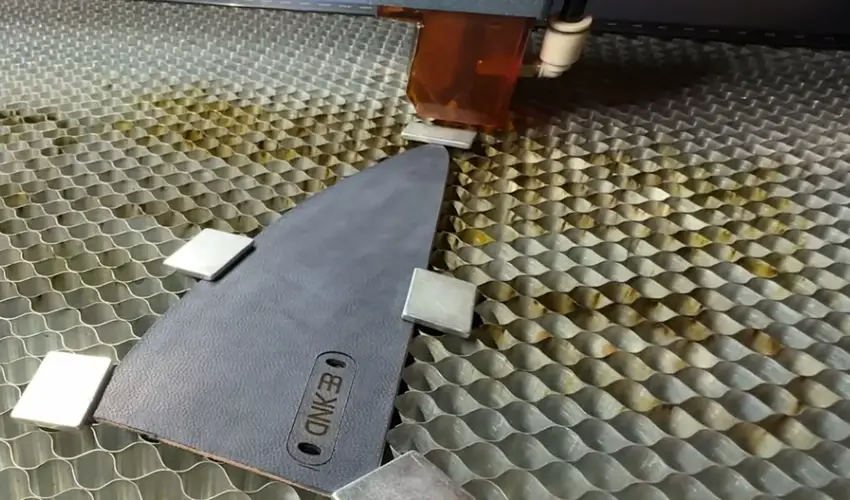
Types of leather you can engrave on
Laser engraving has become a popular method for adding intricate designs, logos, and personalization to leather products. However, not all types of leather are the same, and understanding which types are suitable for laser engraving is crucial for achieving the best results. Below are the main types of leather you can engrave on and what makes each one unique:
Full-Grain Leather
Full-grain leather is the highest quality type of leather you can use for engraving. It comes from the top layer of the hide and retains the natural grain, making it durable and long-lasting. Engraving on full-grain leather results in a distinct and rich texture, where the laser etches directly into the surface, creating a clean, detailed design.
- Best For: Luxury items like wallets, belts, and handbags.
- Characteristics: Thick, rugged, and naturally resistant to wear and tear.
- Engraving Impact: The laser burn marks will contrast well with the leather, creating a striking visual effect.
Top-Grain Leather
Top-grain leather is slightly sanded and buffed to remove imperfections, making it softer and more pliable than full-grain leather. It’s often used in high-end leather goods and provides a smooth surface for engraving, which allows for intricate detailing. However, it’s not as durable as full-grain leather.
- Best For: Custom notebooks, portfolios, and phone cases.
- Characteristics: Soft, smooth finish with a consistent appearance.
- Engraving Impact: Laser engraving on top-grain leather yields sharp, clean lines with a lighter contrast than full-grain leather.
Genuine Leather
Genuine leather is a lower-grade leather made from the leftover layers of hide after the top grain is removed. While it’s not as strong or durable as full-grain or top-grain leather, it can still be engraved effectively. The surface tends to be smooth, but it may not have the same level of texture or finish as higher-quality leathers.
- Best For: Budget-friendly products like belts, bags, and accessories.
- Characteristics: More affordable, with a somewhat artificial finish.
- Engraving Impact: Laser engraving results are more subtle compared to higher-grade leather, but still produce a decent visual effect.
Suede Leather
Suede is made from the underside of the animal hide, giving it a soft, velvety texture. It’s more delicate than other types of leather, but it can still be engraved. However, the engraved designs on suede will appear more muted because of the texture.
- Best For: Shoes, gloves, jackets, and accessories.
- Characteristics: Soft, fuzzy surface with a luxurious feel.
- Engraving Impact: Subtle, textured engraving results that may not be as detailed as on smoother leathers.
Nubuck Leather
Nubuck leather is similar to suede but comes from the top layer of the hide, making it more durable. It has a soft, brushed texture and is commonly used in high-end products. Laser engraving on nubuck creates a darker, more pronounced mark compared to suede, but it’s still softer than top-grain leather.
- Best For: Footwear, handbags, and upholstery.
- Characteristics: Velvety surface with more durability than suede.
- Engraving Impact: Dark, subtle etching that blends with the leather’s natural texture.
Bonded Leather
Bonded leather is made from scraps of leather that are ground up and glued together to form a leather-like material. It’s not as durable or high-quality as other types of leather, but it’s a cheaper alternative for engraving. The results may not be as sharp, and the material can degrade more quickly.
- Best For: Low-cost products like furniture and book covers.
- Characteristics: Inconsistent texture, prone to peeling or cracking.
- Engraving Impact: Can result in uneven or inconsistent engraving due to its composition.
Exotic Leathers
Exotic leathers like alligator, crocodile, ostrich, and snake can also be engraved. These leathers are typically used for luxury items, and their unique textures and patterns make engraved designs stand out. However, the natural scales and textures may affect the precision of the engraving.
- Best For: High-end bags, shoes, and accessories.
- Characteristics: Unique patterns and textures.
- Engraving Impact: Engraving may highlight natural textures, creating a distinct look
Also Read: Choosing the Right Leather for Laser Engraving
What options do you have when engraving on leather:
Depending on what you are trying to achieve and what kind of leather you are working, you’ll have three main options;
- Laser cutting leather – laser cutting is particularly well suited for projects where fine, precise cutting is needed. Make sure you have a laser engraver that is suited for cutting leather.
- Laser engraving leather – if you are looking to achieve an embossed look, then you want to engrave as opposed to cutting your leather. The result will depend on your leather – some leather types will turn darker while others will turn lighter.
- Laser engraved die stamp with laser-cut inlay – This process is used for embossing texture and images into the leather using unheated means.
Things to remember when laser engraving leather
Laser engraving leather can add a personal, artistic touch to various products, from wallets to belts and bags. However, working with leather using a laser requires attention to detail and understanding the material to ensure the best results. Here are essential things to keep in mind when laser engraving leather:
Type of Leather Matters
Not all leather is the same, and the type of leather you choose affects the outcome of your engraving. Full-grain and top-grain leather are the best for laser engraving because they are durable and provide a clean surface for detailed work. Lower-quality leathers, like genuine leather, may not engrave as cleanly, and suede or nubuck may produce more muted results due to their softer texture.
Key Tip: Test the laser settings on a small piece of leather to see how it reacts, especially if you’re working with a new or unfamiliar type of leather.
Proper Laser Settings
Getting the laser settings right is crucial for achieving sharp, clean engravings on leather. Using the correct power, speed, and frequency settings ensures that the laser doesn’t burn or damage the leather. Start with low power and increase gradually to prevent scorching or uneven marks.
Key Tip: Always start with lower power settings to avoid burning or damaging the leather. Adjust the speed and frequency settings for finer details.
Ventilation is Important
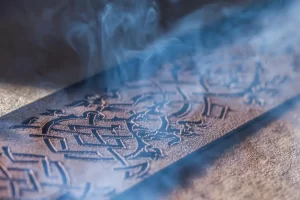
Leather contains natural oils and produces fumes when it is engraved, which can be harmful if inhaled.
Proper ventilation or a good exhaust system is necessary when laser engraving leather to ensure that the workspace stays safe and odor-free.
Key Tip: Make sure your laser engraver is equipped with an exhaust system or work in a well-ventilated area to reduce exposure to fumes.
Our Buying Guides Can Be Found Here:
1. Top 5 Laser Engraver Exhaust Fan Options: Best Quality!
2. Best Fume Extractors for Laser Engravers: 5 Quality Options!
3. Laser Engraver Enclosure Options: You Need The Best Quality
Avoid Synthetic Leathers
Synthetic leathers, like PU or bonded leather, may not engrave as well as natural leathers. They can melt, produce harmful fumes, and generally yield poor engraving results. Stick to natural leather types for the best results when laser engraving.
Key Tip: Verify that the leather you’re using is natural, as synthetic leathers can produce hazardous fumes and give unsatisfactory engraving results.
Clean the Leather Before Engraving
Leather often contains oils, dust, or debris that can interfere with the engraving process. Wipe down the leather with a soft, damp cloth before engraving to ensure the laser interacts directly with the surface, not contaminants.
Key Tip: Clean the leather surface with a cloth before engraving to remove any dust, dirt, or oils that may affect the final result.
Test Before Full Engraving
Laser settings vary depending on the type of leather, the design, and the desired depth of the engraving. Testing your settings on a scrap piece of leather before engraving your final product helps ensure that the design comes out as expected.
Key Tip: Run a test engraving on a sample piece of the same leather to ensure you have the correct settings before starting your main project.
Engraving Depth and Design
Leather can be engraved to different depths depending on the effect you want. A shallow engraving will add a subtle touch, while a deeper engraving creates a more pronounced design. Be cautious with extremely intricate designs, as leather may not hold very fine details as well as other materials.
Key Tip: Adjust the engraving depth depending on the leather’s thickness and texture. Avoid overly detailed designs if you are engraving on textured leather like suede.
Post-Engraving Care
After engraving leather, it’s important to finish it properly to maintain the quality of both the engraving and the leather itself. Applying a leather conditioner or protective sealant can help preserve the engraved design and keep the leather supple.
Key Tip: Use a leather conditioner or sealant after engraving to protect both the design and the material.
Pay Attention to Grain and Texture
The grain and texture of leather can impact the engraving outcome. Full-grain leather has natural marks that may add character to the engraving, but they can also distort fine details. Plan your design with the leather’s grain in mind.
Key Tip: Choose a leather with a consistent grain for projects requiring detailed designs, and factor in the texture for larger, more straightforward engravings.
Customization Possibilities
One of the key benefits of laser engraving leather is the ability to personalize products. Whether for gifts or branding, leather engraving offers endless possibilities for logos, names, and intricate designs, making each product unique.
Key Tip: Consider adding personalized elements like initials, logos, or custom artwork to make your leather engraving projects more unique and valuable.
Final Thoughts
Laser engraving leather offers endless creative possibilities, but the key to achieving professional results lies in understanding the material, proper machine settings, and post-engraving care. Always test your settings, ensure proper ventilation, and choose the right type of leather for the best results. Whether you’re crafting a personalized gift or a unique leather product, keeping these factors in mind will help you create stunning engraved designs.

